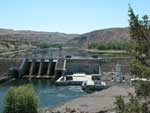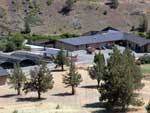| Another critical natural resource-based, economic development initiative is that of the Warm Springs Power Enterprises. In 1955 Portland General Electric (PGE) wanted to install a series of dams on the Deschutes River, known as the Pelton Project. The Confederated Tribes of Warm Springs entered into an agreement with PGE that will eventually lead to the Tribes’ implementation of a controlling interest and ownership in the project. The three dams are the Round Butte, Pelton and Pelton Reregulating dams. The Pelton Reregulating Dam, with its unique “submarine-like” turbine hydroelectric generator, went on-line in 1982. With the other dams, over 460 megawatts of electricity are generated annually. Much of the revenues from the sale of the electricity, in turn, go back into helping provide various services coordinated by the Confederated Tribes of Warm Springs to its members. Together with the Warm Springs Forest Products Industries, these two enterprises account for 70 to 80 percent of the tribal governement and services annunal funding. The Confederated Tribes of Warm Springs is the first tribal group to be issued a Federal Regulatory Commission licence to operate a hydroelectric facility.
|
|
Ralph Minnick talks about the Pelton Project, the hydroelectic dams and their development as part of the Warm Springs Power Enterprises. Part 1 (Interviewed by Rodney Frey, June 2003) |
Warm Springs Power Enterprises is planning to construct a new intake tower at Round Butte Dam, thus allowing salmon to better spawn upstream from the project. The Enterprise is also looking into the potential of harnessing wind energy and developing a “wind farm” on tribal lands. Wind speeds and durations are currently being monitored.
|
|
Ralph Minnick continues considering the Pelton Project and its unique hydroelectic generating process. Part 2 (Interviewed by Rodney Frey, June 2003) |
|
|
James Noteboom, Tribal Attorney, talks about legal developments connected with the Pelton/Round Butte Hydroelectric Project and water rights. (Interviewed by Brigette Whipple, June 2003) |
Managed by the United States Fish and Wildlife Department, the Warm Springs National Fish Hatchery was established in 1966 and began operations in 1978. Its primary mission is not only to stock the reservation waters with salmon, but importanly, to assist with the overall restoration of the spring chinook salmon throughout the region. The hatchery is located on the Warm Springs Reservation along the Warm Springs River, a tributary of the Deschutes River, which flows into the Columbia. While operated by the U.S. Fish and Wildlife Service on lands leased from the Confederated Tribes of Warm Springs, the hatchery works in close cooperation with the Confederated Tribes of Warm Springs who has ultimate responsibility for fishery resources on the reservation.
|
|
Mavis Shaw, Assistant Manager and Fishery Biologist, talks about the yearly operational cycle of the Warm Springs National Fish Hatchery, from brood salmon to fry to smolts. She also talks about the prayers given for the salmon, the First Fish Ceremony (Salmon Feast), and the "happy times." (Interviewed by Rodney Frey, July 2003) |
To learn more about the salmon and its life cycle, the challenges it faces, as well as the Warm Springs National Fish Hatchery role in the restoration of the salmon, go to the Warm Springs National Fish Hatchery site.
|
|
Mavis Shaw considers the ecological and cultural significances of the hatchery and salmon for all the peoples, and reflects on some of the challenges the salmon face today. She also talks about the role of "yellow flowers" for the salmon. (Interviewed by Rodney Frey, July 2003) |
Kah-Nee-Ta High Desert Resort and Casino is another of the Warm Springs Tribal Enterprises. Unlike the Forest Products and Power Enterprises, the “natural resource” it nurtures and develops is that of human recreation and enjoyment. As the tribal members once gathered at Celilo Falls to socialize and recreate, along with fishing and trading, so now do people gather at Kah-Nee-Ta. The resort offers many services to its guests, including golfing, swimming, kayaking on the Warm Springs River, horseback riding in the nearby hills, relaxation in the spa, fine dinning, convention and conference accommodations, and, of course, casino fun!
|
|
Margie Tuckta, Director of Human Resources for the Kah-Nee-Ta High Desert Resort and Casino, talks about many of the services and oppurtunities offered by the resort. Margie also relates the meaning of the word, "kah-nee-ta." (Interviewed by Rodney Frey, July 2003) |
As is still the case today, the Warm Springs, Wasco and Paiute peoples have always enjoyed betting on horse races, stick games and various types of cardgames. The gaming activities associated with the Kah-Nee-Ta Casino operations reflect a long tradition of sporting and betting among Indian peoples. The games of chance have always provided important opportunities to socialize and enjoy each others company, to provide additional sources of cash as well as share one’s wealth with others, and to offer a spark of excitement and anticipation. The revenues gained from the casino operations are an important source of tribal revenue, helping provide health, education, youth and elder's programs, and social services to tribal members. In addition, the resort and casino are major employers on the reservation, providing a livelihood, and a sense of accomplishment and pride to a significant number of tribal members and their families.
|
|
Margie Tuckta, considers some of the important contributions the Kah-Nee-Ta High Desert Resort and Casino have brought to the Warm Springs people, including employment oppurtunities, tribal funding revenue and pride. (Interviewed by Rodney Frey, July 2003) |
© Confederated Tribes of Warm Springs 2003
< previous | next >
|
















